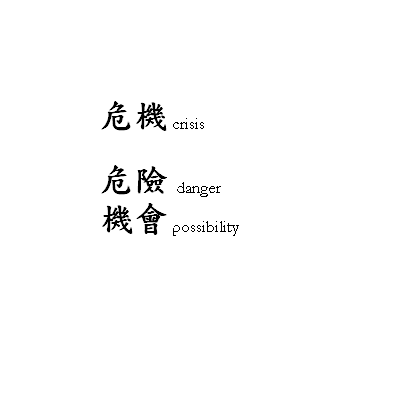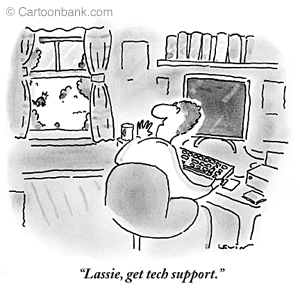CAIS
Workshop So Many Tools, So Little Time, November 20, 2008: Digital Poems and Stories Presented by Bill Sullivan
Adjusting Students' (and adults') Mindsets When Using Technology
in the Classroom |

|
 |
Adjusting Mindsets:
- Reflect on Robert Brooks' insights on crisis, danger and possibility (celebrate the Chinese characters); the etymology of resilience; how can we change mindsets?
- introduce the pay it forward collaboration ethos: complete a step on your project and then help someone do the same on their project (mindset shift and change of learning environment);
- have students take turns using the lead computer that is attached to the projector and have them voice out loud their problem solving steps;
- release the Will Richardson's (CAIS Tech. Keynote 07) "Yeah but" brakes and explore the new potential for networking and model learning in a 2.0 world;
- 21st century literacy check: realize the environments that you already know before you learn a new system/software; in other words, what types of learning will you have to do: relearning? upgrading? unlearning?
- join the circle and allow these projects to become naturally student-centered work projects where the teacher can also engage students
to help create the criteria for assessment since technology assignments defy or challenge normal
grading standards: David Warlick (CAIS Tech. Keynote 06) has a create your own rubric on his page (or try this link if previous one is down). Here's an interesting resource, Midlink Magazine, with examples of examples of student rubrics. Here's one from the San Mateo County Project-Based Learning page. Have your students either create individual rubrics per assignments or research other options.
- become a role model for learning--these projects allow me to role model my love for learning because there is a good chance that students
know more than me in various technology topics, and I can genuinely compliment them on their usefulness and assistance;
- also create a great collaborative environment and a sincere learning community; students do respond well when you expect more from them as co-investigators. "Treat people as if they were what they ought to be, and you help them to become what they are capable of being." --Johann Wolfgang von Goethe;
return to top
Classroom Management:
- Overall, it is important to have a trust discussion with students before
the groups and individuals go off on their own. You can also use Robert Brooks' model where he asks students to create conduct goals and misconduct consequences.
- This teacher has some great instructions for organizing the various steps
for a digital storytelling project. He is also working with fourth and fifth
graders in a public school in Lexington, MA.http://www.infotoday.com/MMSchools/jan02/banaszewski.htm
- Kenton County School system in Kentucky has a great web page that is a resource for students as well as teachers: http://www.kenton.k12.ky.us/DigitalStory/dstindex.htm#teachers
- Here is a link that walks teachers through the steps of scripting, filming, editing and showing a movie as a classroom project. http://kidsvid.altec.org/
- Try the NEA's "works4me" tips library; they have a whole section devoted to suggestions from real teachers using technology in the classroom. "There's a lot of talk about technology and education, but for many teachers, getting down to the nitty gritty of actually using it is another matter. For one thing, it takes time learn new software, and more time to decide how best to apply it. Here are concrete examples of how some teachers are integrating technology into their daily classroom life."
- There are many resources for teachers at the Education World Technology Center; here a little fun start to using technology in your classroom every day: http://www.educationworld.com/a_tech/tech/tech146.shtml
- NB: the most interesting aspect about digital stories and poems is how absorbing they are to students and adults. Thus, the more you can taylor your curriculum to allow for these projects, the more meaningful absorption of your curriculum you will observe. Once you involve your students in such a project, you will see how their fascination with creating a meaningful multimedia presentation becomes the best classroom management barometer.
return to top
Some digital samples:
Prompts for poems and stories:
- Poetry: find a favorite poem and create a digital poem. Click here for the Academy of American Poets. http://www.poets.org
- Story: download the latest version of the essay prompts on the Common Application page: http://www.commonapp.org/
- Write about your personal mythology. Write about a childhood activity where you were so engrossed in the play that you did not notice time passing. You could also excavate an early memory from your childhood--perhaps a moment of which you were too young to remember--that family members tell and retell. What is that story? Why is it so important for you?
- During our spring term, my classes wrote essays for the essay contest, This I Believe; it is a recurring program on National Public Radio's Morning Edition. Because the contest asks Americans to reflect on their core beliefs, sharing these core values became another way to build better relationships among the students in my classroom.
return to top
Seven Elements of a Digital Storytelling
The Center for Digital Storytelling set an interesting criteria that incorporates
the aspects of multimedia. Because multimedia presents so many different ways
to present a story, as useful guideline such as this one will help channel and
focus students' energies and ambitions.
They have synthesized these seven elements as a way to channel diverse backgrounds
and approach the digital storytelling process with a good general guideline.
I have had students make I-movies, and I will now begin criteria conversations
with these seven elements. The fun begins when you open the floor to students
to create the class standards before the project begins.
In the interest of time and convenience, click
here for a boiled down version of CDS' seven elements:
- Point of View
- Dramatic Question
- Emotional Content
- Gift of Your Voice
- Power of Soundtrack
- Economy
- Pacing
Brainstorming and Outlining a Digital Story
Click here for a great storyboard outline (pdf file)
designed by John Lambert.
return to top
Directions for I-Movie. Before we begin,
it is good to sit back and evaluate some I-Movie skills and techniques that you
probably already possess. We will be operating moves in a click and drag environment.
We will also be working with the Palette and Timeline,
so it is important that you understand those features as well as the concepts
of importing (images, sound, etc) and Sharing
(sometimes referred to as export in previous versions of I-Movie).
return to top
NB Links and Ideas to prompt reflections and
conversations:
General Discussion on Digital Storytelling:
- What is Digital
Storytelling? Reflections from John Lambert of CDS
- The BBC's Capture
Wales: This BBC site hosts "mini-movies created and edited by ordinary
people from Wales--using cameras, computers, scanners and their own photo
albums. Everyone has a story to tell and new technology means that anyone
can create a story that can show on a web site. The idea is to show the richness
of life in Wales through stories made by the people of Wales. It's you who
decide what those stories are."
- Eastgate is a great site for hypertext (fiction, non-fiction, and poetry) as well as software & tools: http://www.eastgate.com/
- Dr. Helen Barrett's Electronic
Portfolios homepage; she has used CDS as a source for operating digital
storytelling workshops.
- Educational Video Center in New York City: This center has some great student work and teachers can sign up for courses on how to have students use video technology in their classroom. http://www.evc.org/
Other Multimedia Links:
return to top
Search Tips: try these links on the web
to gather multimedia images, files, etc, for your digital story:
return to top
Copyright Information:
return to top
Great Source: I began collecting much of the
above information from John Lambert, Dana Atchley, Nina Mullen, The
Center for Digital Storytelling: They have a great web page in which
they present the fundamental steps with the metaphor of a cookbook
and display a great movie
example as a type of recipe as a goal for the showing the multimedia potentials. This center and subsequent Digital Storytelling Association has been at the core of the digital movement for some time.
Bill Sullivan; last updated November 19, 200 return to top


